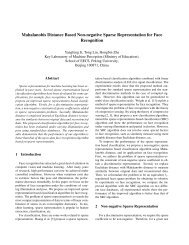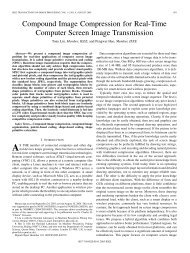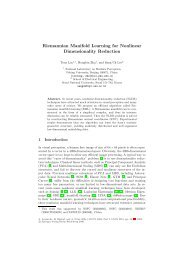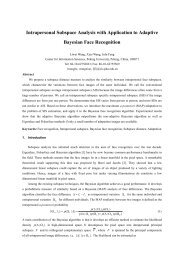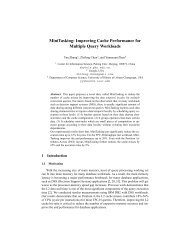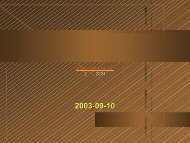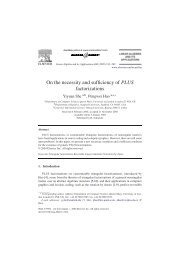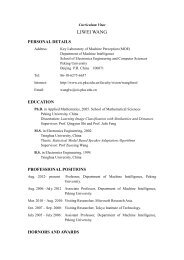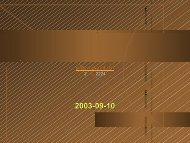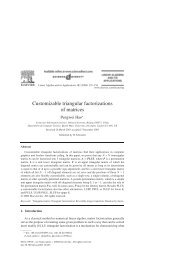monitoring an intersection using a network of laser scanners
monitoring an intersection using a network of laser scanners
monitoring an intersection using a network of laser scanners
Create successful ePaper yourself
Turn your PDF publications into a flip-book with our unique Google optimized e-Paper software.
MONITORING AN INTERSECTION USING<br />
A NETWORK OF LASER SCANNERS<br />
H. Zhao, J. Cui, H. Zha,<br />
Peking University<br />
K. Katabira, X. Shao, R. Shibasaki,<br />
University <strong>of</strong> Tokyo
Background (1)<br />
Analyzing <strong>an</strong>d Monitoring<br />
the traffic behavior in <strong>an</strong><br />
<strong>intersection</strong><br />
Efficiently <strong>an</strong>d accurately<br />
COLLECTING the TRAFFIC<br />
DATA in <strong>an</strong> INTERSECTION<br />
Real-timely DETECTING<br />
DANGEOUS SITUATIONS.
Background (2)<br />
• Vision-based methods suffer mainly on the<br />
following difficulties<br />
–Occlusion<br />
– Computation Cost<br />
– Illumination Ch<strong>an</strong>ge<br />
To solve the problems<br />
e.g. the camera is<br />
required to be set on a<br />
tall position,<br />
<strong>monitoring</strong> <strong>intersection</strong><br />
from the above<br />
1. Restrict camera’s setting condition<br />
2. Target on a simplified situation<br />
e.g. monitor<br />
vehicles <strong>of</strong><br />
limited l<strong>an</strong>es, do<br />
not discriminate<br />
moving objects.
Objective<br />
This research propose a novel system for<br />
<strong>monitoring</strong> <strong>an</strong>d collecting detailed traffic data,<br />
with easy setting condition, in <strong>an</strong> environment <strong>of</strong><br />
complicated traffic behavior, such as <strong>intersection</strong>,<br />
<strong>using</strong> a <strong>network</strong> <strong>of</strong> single-row <strong>laser</strong> sc<strong>an</strong>ner.
Pedes.<br />
Car<br />
#1<br />
System Image<br />
Server PC<br />
Bicycle<br />
#2<br />
Car<br />
An image <strong>of</strong> integrated <strong>laser</strong> data<br />
Network<br />
#1<br />
Laser Sc<strong>an</strong>ner<br />
#2<br />
Laser Sc<strong>an</strong>ner
Road<br />
side<br />
LD3<br />
LD1<br />
Road<br />
side<br />
LD1<br />
Safety<br />
zone<br />
Safety<br />
zone<br />
LD2<br />
Integrated frame<br />
Single <strong>laser</strong> frame<br />
LD3<br />
10m<br />
Single <strong>laser</strong> frame<br />
LD2<br />
Single <strong>laser</strong> frame
Client<br />
Processing Flow<br />
Laser Sc<strong>an</strong>ner1<br />
Measure data<br />
Laser Sc<strong>an</strong>ner N<br />
Measure data<br />
BG Generation<br />
BG Subtraction<br />
…<br />
BG Generation<br />
BG Subtraction<br />
Clustering<br />
Clustering<br />
Network<br />
Server<br />
1. Data Integration<br />
2. Detection<br />
3. Tracking<br />
4. Recognition<br />
Moving object
Processing Modules<br />
Server<br />
Network<br />
Recognition<br />
Tracking<br />
Detection<br />
Data Integration<br />
Clustering<br />
Moving object<br />
Calibration, Synchronization<br />
Clustering<br />
BG Generation<br />
BG Subtraction<br />
BG Generation<br />
BG Subtraction<br />
Client<br />
Measure Data<br />
Laser Sc<strong>an</strong>ner 1<br />
…<br />
Measure Data<br />
Laser Sc<strong>an</strong>ner N
Server<br />
Recognition<br />
Frame k<br />
Tracking<br />
Detection<br />
Data Integration<br />
trajectory<br />
state<br />
group<br />
observation<br />
Network<br />
Clustering<br />
cluster<br />
BG Generation<br />
BG Subtraction<br />
Client<br />
Measure Data<br />
LD1 LD2 LD3<br />
Data Structure
Difficulties
Difficulty 1
The data <strong>of</strong> the same object might be spatially disconnected
Difficulties
The data <strong>of</strong> different objects might be spatially close<br />
There are different kinds <strong>of</strong> objects, complicated motions
Task 1<br />
We are not able to rely only on dist<strong>an</strong>ce,<br />
size, shape, location etc for detection<br />
<strong>an</strong>d traction.<br />
We need to find some other clues to<br />
associate the data <strong>of</strong> the same object<br />
together.
Data Feature<br />
A car<br />
s<br />
e<br />
u1<br />
c<br />
u2
Data Feature<br />
v4<br />
u<br />
u<br />
u<br />
u<br />
v3<br />
v1<br />
u<br />
u<br />
u<br />
v2
Data Feature<br />
u<br />
u<br />
u<br />
u<br />
u<br />
u
Object Model<br />
(c, val)<br />
(v3, sv3)<br />
u<br />
(v4, sv4)<br />
p<br />
(v2, sv2)<br />
dirv<br />
u<br />
len2<br />
(v1, sv1)<br />
len1<br />
(v1=dirv)
Difficulty 2<br />
The current<br />
frame<br />
The previous<br />
frame<br />
More sensors bring more confusion in data association
Task 2<br />
Data association is difficult when facing a<br />
complicated environment such as <strong>an</strong><br />
<strong>intersection</strong>, where different kinds <strong>of</strong> objects,<br />
different motion patterns exist.<br />
Also, a large number <strong>of</strong> distributed sensors will<br />
bring more difficulties in data association.<br />
A data association algorithm is required to tackle<br />
the confusions.
A r<strong>an</strong>ge stream<br />
Sc<strong>an</strong> <strong>an</strong>gle (within a <strong>laser</strong> sc<strong>an</strong>)<br />
a static object<br />
a moving object<br />
Time (A stream <strong>of</strong> <strong>laser</strong> sc<strong>an</strong>s)
A simple clustering result<br />
Time (A stream <strong>of</strong> <strong>laser</strong> sc<strong>an</strong>s)<br />
Sc<strong>an</strong> <strong>an</strong>gle (within a <strong>laser</strong> sc<strong>an</strong>)
Data Association Method<br />
k-1 k<br />
trajectory<br />
New trajectory<br />
3<br />
group<br />
2<br />
cluster<br />
1<br />
LD1 LD2 LD3 LD1 LD2 LD3 LD3
Experiment<br />
Laser Sc<strong>an</strong>ner<br />
Video Camera<br />
Sports Center<br />
Peking Univ.<br />
Overhead Bridge<br />
Peking Univ.
40cm<br />
激 光 扫 描 仪
Summary<br />
We propose a novel system for <strong>monitoring</strong> <strong>an</strong>d collecting<br />
detailed traffic data, with easy setting condition, in <strong>an</strong><br />
environment <strong>of</strong> complicated traffic behavior, such as<br />
<strong>intersection</strong>, <strong>using</strong> a <strong>network</strong> <strong>of</strong> single-row <strong>laser</strong> sc<strong>an</strong>ners.<br />
Future Topics<br />
• Accuracy evaluation<br />
• Recognition module<br />
• F<strong>using</strong> <strong>laser</strong> sc<strong>an</strong>ner with video camera



